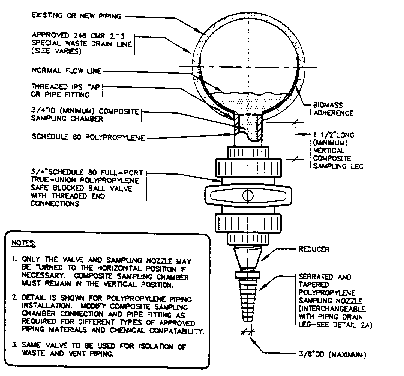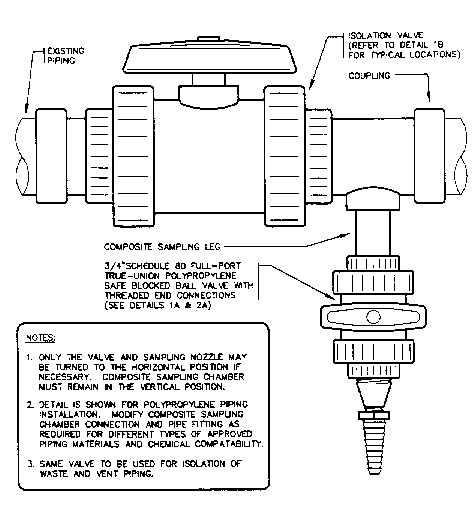
Figure 9.1 Standard MWRA Sampling Port (Cross Section View)
Source: Flow Tech Associates, Inc., Detail 1A
The validity of results from any laboratory testing is dependent upon the sample being representative of the source from which it was taken. It is the operator's responsibility to see that all personnel who might participate in the sampling program be personally instructed as to the appropriate sample techniques. The two types of samples taken for wastewater laboratory analyses are known as grab samples and composite samples, and each can be obtained either manually or automatically.
A grab sample is an individual sample which is taken from a wastestream on a one-time basis without regard to the flow in the wastestream. These samples must be collected over a period of time not exceeding 15 minutes. A grab sample shows the wastestream characteristics at the time the sample is taken.
A composite sample is a combination of individual samples of wastewater taken at pre-selected intervals to represent the integrated composition of a wastestream. A composite sample is always to be collected over the entire process day ( or as close to it as possible). Although the MWRA's regulations 360 CMR 10.00 requires at least 8 grab samples to make up a composite sample, it does not follow that 8 samples taken over a time period of 2 hours for an industry that discharges for 8-24 hours is acceptable. In all cases, even if it is necessary to overlap calendar days, the composite must cover the entire process day. The daily average limit, the highest allowable concentration for any pollutant in a wastestream discharged during one day by an industrial user, is based upon a representative composite sample.
A composite sample can be prepared proportionally according to time or flow. A composite sample based on time can be obtained if the flow of the wastestream is relatively constant over the entire time period, even though the wastestream characteristics may change. In this case, equal amounts of each individual sample can be combined into one composite sample. To prepare a flow-weighted composite sample, each individual sample is combined with the others in proportion to the volume of flow at the time the sample was collected.
Permit sampling shall be representative of the typical volume and nature of the permittee's discharge. The sample must be taken at a location, permitted by the MWRA, that is free of any uncontaminated water, sanitary waste or other non-process water. These samples shall be collected, preserved and handled in accordance with the procedures established in 40 CFR Part 136 and amendments. When performing permit sampling, it is important to review your discharge permit for the correct sample type. Each individual pollutant/parameter requires either a grab or composite sample. A mercury sample obtained via composite sampling at an MWRA permitted discharge location during a representative discharge event at a location free of any uncontaminated water, sanitary waste or other non-process water is an example of a reportable sample under the MWRA's SMART program (See Section 9.3 for SMART definition).
The results of analysis of representative samples obtained beyond the requirements of an institution's discharge permit, for any pollutant/parameter being discharged, using test procedures prescribed in 40 CFR Part 136 or other United States Environmental Protection Agency (EPA) approved methods, are required to be submitted to the MWRA.
Samples obtained outside of these requirements are not representative and should not be submitted to the MWRA as SMART data. Mercury results of a grab sample obtained or those from a non-permitted MWRA sampling location may be an example of a non-SMART reportable result. The results are non-reportable because the sample was obtained via a grab sample and at a non-permitted location. Appendix F contains a copy of a letter from Mr. Eugene B. Benson, Associated Counsel for MWRA, TRAC to Mr. Robert K. Gingras, Senior Project Manager for EARTH TECH (formerly HMM Associates) clarifying when to and when not to submit sampling data.
When performing sampling, it is important to establish a set of standard operating procedures. This will allow a facility to obtain representative samples repeatedly. Presented in Appendix A is a copy of the MWRA's Standard Operating Procedures (SOP) from their sampling manual. It would be advantageous to develop a SOP very similar to the MWRA's
It is important to clarify the difference between SMART and NON-SMART reporting requirements. Self-Monitoring Analytical Report Tracking (SMART) is a program the MWRA has provided to all DEP Certified Laboratories. The SMART program generates both a computer diskette containing the sampling analysis results and a paper copy of the information on the diskette. The MWRA enters the results from the diskette into its computer system and retains the paper copy in the permittee file.
A summary of the MWRA's permit sampling requirements are as follows:
Refer to the copy of Mr. Eugene Benson's letter presented in Appendix F and your current MWRA permit for additional SMART data reporting clarification.
The MWRA has developed and published written standard sampling port guidelines for its permitted Industrial Sewer Users. Figure 9.1 and 9.2 illustrates a detailed cross section and elevation view of a standard sampling port developed by Flow-Tech Associates, Inc., on behalf of the MWRA Infrastructure Subcommittee, and presented to the MWRA for approval. The MWRA has approved and prefers this "Typical" design set-up, but this is not the only type of sampling port that is approved by the MWRA.
The sampling port, in most instances and especially during low flow situation, is only designed for a single sampler. Sampling locations that are equipped with single sampling port are to be used on a first come first serve basis. Example: Self-monitoring sampling has begun and the MWRA shows up to perform their required unannounced sampling. If an institution has already begun sampling, prior to the MWRA's arrival, the MWRA would be obligated to reschedule their sampling. The MWRA would not force an institution to terminate its sampling to fulfill their own sampling requirements. Although it is possible to have a dual sampling port at the same location it is strongly discouraged for the following reasons:
Both of these issues are variables which will effect the quality of the sample and produce non-representative data. These are sampling conditions that should be avoided.

Figure 9.1 Standard MWRA Sampling Port (Cross Section View)
Source: Flow Tech Associates, Inc., Detail 1A

Figure 9.2 Standard MWRA Sampling Port (Elevation View)
Source: Flow Tech Associates, Inc., Detail 2B
| Previous | Contents | Next |